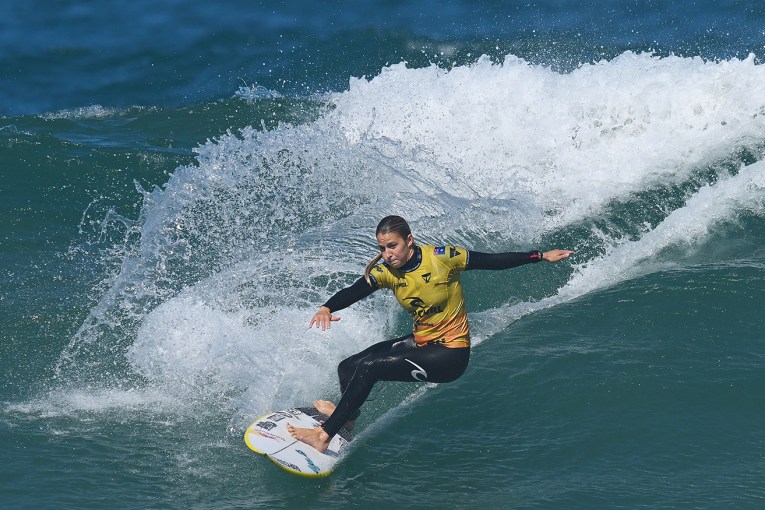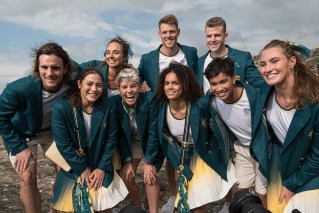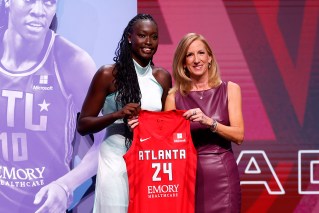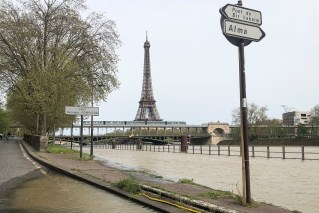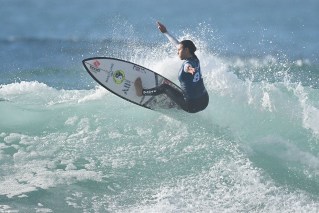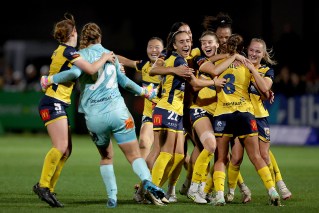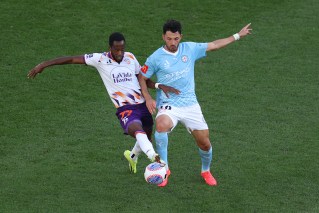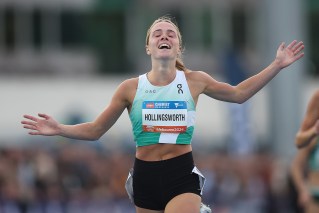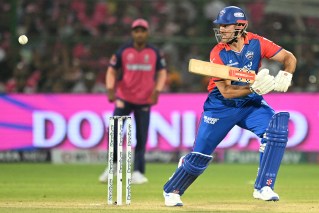Unfinished business drives Ash Barty amid Australian Open’s tales of the unexpected

“Oh, we’re not done yet,’’ said Ash Barty, when asked about reaching the Australian Open quarter-finals for the third consecutive year.
Exciting?: Yes. Satisfied?: No.
“We will keep chipping away and keep trying to do the right things to progress as far as we can.”
It mattered not that the vast Rod Laver Arena was empty of fans cheering the local favourite, nor that some of the canned TV applause was oddly ill-timed.
Barty’s timing was as impeccable as her tactics during a 6-3 6-4 defeat of American Shelby Rogers that took just 71 minutes and made her the first Australian in 37 years to reach three consecutive Australian Open finals.
She served exceptionally well, with her tournament average of five aces included among 21 winners to Rogers’ 14 and 16 unforced errors to 25.
Wary of the threat of the American’s power, she displayed plenty of her own, with the forehand a staple, but including good use of the topspin backhand, too.

Ash Barty is happy with her efforts on Monday night. Photo: AFP/Getty
Hard to believe, sometimes, that this is just week three of competition for the world No.1, who is on an eight-match winning streak after a 50-week break from competition.
Not her first extended absence, of course, having returned in 2017 after very different reasons for being away.
“It’s all part of my journey. It’s all part of my life, my story, I suppose,” she said.
“Obviously used to in a way coming off a break and not playing. The break itself is not a problem for me. It’s not a concern.”
Nor, fortunately, does her still-strapped left thigh seem to be.
This is a very different quarter-final run from 2020 in other ways, though, for the circumstances and feel are so unfamiliar.
“I think I have learnt a lot about myself over the past 12 months. The world is in a bit of a different place to what it’s ever been before,” Barty said.
“So I think I’m just extremely grateful that I’ve got another opportunity to do something that I love out on one of the most beautiful courts in the world, on the biggest stage for us as Aussies playing tennis, which is really cool.”
Last Eight 💜 pic.twitter.com/7ReVJmzpMP
— Ash Barty (@ashbarty) February 15, 2021
Barty is still yet to drop a set but, as it was in the second round against Daria Gavrilova, the Queenslander failed to serve out the match at her first attempt at 5-2.
A minor quibble, though, and if that is the worst that can be said about Barty’s 71-minute performance against the world No.57 then she is travelling well, indeed.
And now into the last eight, where Barty plays Czech 25th seed Karolina Muchova as she seeks to repeat her semi-final effort from last year.
She won her only match against Muchova, at the 2018 US Open, with potential danger opponent Elina Svitolina having been removed from her path by American Jessica Pegula.
Unseeded Jessica Pegula had never won a game in Melbourne and was even considering giving up on tennis for good – now she's notching up stunning firsts and building her own legacy, @matte_johnson reports. #AO2021https://t.co/pQmUZOn3pv
— The New Daily (@TheNewDailyAu) February 15, 2021
Muchova was a qualifier in her previous match against Barty, which both recall fondly.
“We play a bit similar, I would say,” said the Czech, who likes to slice and volley.
“I remember that after match she actually told me, like, to keep working, that I can make it to the top. So that was nice.”
Yet if Barty’s progress was rather predictable, and the marquee women’s quarter-final match-up is Serena Williams against Simona Halep, then what about the tales of the less expected?
FROM QUALIFYING TO QUARTER-FINALS 🙌
🇷🇺 Aslan Karatsev continues his dream #AusOpen run with a 3-6, 1-6, 6-3, 6-3, 6-4 comeback win over Auger-Aliassime. pic.twitter.com/FaOqGtNudE
— ATP Tour (@atptour) February 14, 2021
That’s an easy one in the men’s draw, where world No.114 Aslan Karatsev is the first qualifier to reach this stage of a grand slam since Bernard Tomic at 2011 Wimbledon, and the first man since Romanian Alex Radulescu in 1996 to do so on debut.
Not since Patrick McEnroe in 1991 has a male ranked so low been among the last eight at Melbourne Park.
Having gone from support act behind top-10 Russian teammates Daniil Medvedev and Andrey Rublev at the ATP Cup to breakout star in his own right, the 27-year-old who had already eliminated world No.9 Diego Schwartzman overcame a two-sets-to-love deficit to continue his seed-stomping run past Canada’s Felix Auger-Aliassime and into the path of Dominic Thiem’s conqueror Gregor Dimitrov.
After spending the COVID-19 hiatus outside the top 250, Karatsev resumed by winning 18 of his past 20 Challenger tour matches and two titles.

Russia’s Aslan Karatsev is interviewed after his win over Canada’s Felix Auger-Aliassime on Sunday. Photo: AP
This, though, is a monster step up, likened by Andre Agassi’s former coach Brad Gilbert to a third division English soccer team suddenly starring in the Premier League.
“This is the beauty of tennis,” Gilbert told the ATP website.
“We’re seeing a lot more guys that are aged 25-plus, who have been career Challenger players, who, all of a sudden, they’ve worked on their game. Some guys aren’t mentally ready to blossom at 21.
“It just shows you that if you keep working with a positive attitude, then all of a sudden, if you’re ready for (an) opportunity, sometimes you can take advantage of it. This is the greatness of tennis, sports. The best story. I love stories like this.”
Karatsev plays aggressively from close to the baseline, serves big, likes to keep points short. Surprised to be here? “I try not to show it,” he said with a laugh.
“It’s impressive, but I was working a lot, and it just happened right now. It’s like you never know when it happens. It just happened here.”
It has been occurring for Medvedev and Rublev for a while and this is the first time in the Open era that three Russian men are in the quarters of a major, with one semi-finalist guaranteed.
Leaving Melbourne Park today, I saw a photographer snapping the three Russian men in the QFs. They're not emoting whatsoever. So they're told: "Smile! Jump! Do something!"
All I'll say is they didn't comply. And watching it unfold absolutely sent me. #ausopen
— Matt Johnson (@matte_johnson) February 15, 2021
Yet Medvedev also spoke of Karatsev’s achievement as “something exceptional’’, and Dimitrov is determined not be seduced by the romance of the storyline.
“Every match you are here is for a reason,” said the Bulgarian former world No.3.
“Whether it’s a fairytale or not, it’s a match. You’ve got to be ready. He’s a dangerous player, playing with a lot of confidence … It takes time for everyone to get to somewhere.”

Taiwan’s Hsieh Su-Wei continues to surprise with her unorthodox play. Photo: AP
In the women’s draw, Hsieh Su-Wei has finally made it to the ball, the unsponsored world No.71 forced to buy her own clothes, shoes and accessories (ie. racquets), but into the quarter-finals for the first time in 38 attempts, at the age of 35.
Hsieh is a quirky, late-blooming Cinderella, admittedly, coached by former Australian Open tournament director Paul McNamee, and with an unorthodox style that can befuddle and torment.
Reigning US Open champion Naomi Osaka sighed audibly when asked about her next opponent, having just survived three match points against Garbine Muguruza in the fourth round.
Not a quarter-final to look forward to, said the world’s highest-paid sportswoman, given that four of their five matches have gone the full distance.
“I felt like there wasn’t a lot of things I could control while I was playing her,” said Osaka, bemused by a follow-up question about what makes Hsieh so challenging.

Naomi Osaka finds her quarter-final opponent hard to read. Photo: Sipa USA
“I mean, have you watched her play? It’s like ‘what?’ She’s one of those players that, for me, if it was a video game, I would want to select her character just to play as her. Because my mind can’t fathom the choices she makes when she’s on the court. It’s so fun to watch. It’s not fun to play.”
Nor always predictable to coach, apparently, for McNamee described the tricky Taiwanese as “a free spirit”, who cannot be kept in a box.
She had never been for a run when they started to work together, once played a match unaware she had a broken string, and can play for years with the same racquet.
“There’s only one Su-Wei,” McNamee said.
“There’s times when she’s kind of focused and other times when she really is not motivated at all to practise. I’ve experienced it where she’ll just go and hit one or two balls, didn’t hit them well. That’s it, she won’t play any more that day. Wasn’t feeling it.”
But, when she does, Hsieh is proud to show people that tennis is not about money or sponsors, singles or doubles.
In the former, she has three career titles and a handful of top-10 wins, including one over Bianca Andreescu last week; in the latter she is a triple grand slam champion and current world No.1.
“Doesn’t matter, just try to keep play. You still can go to somewhere you never dream, you never think about it,” Hsieh said.
“This is what happen, I doing. I’m very happy that I made it, some good level. It can show a lot of people that anything can happen. Just keep working hard.”
